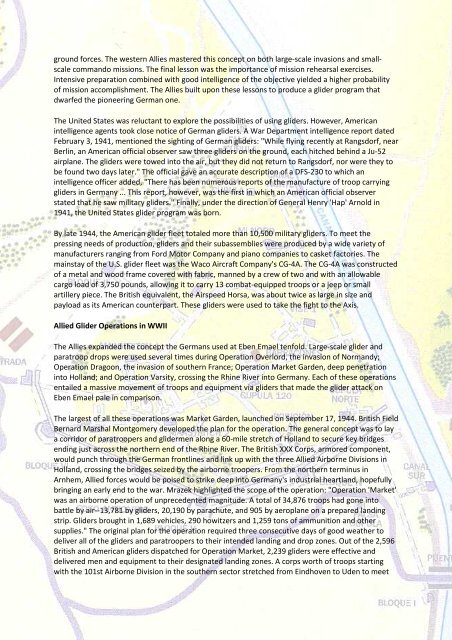Glider assault on Eben Emael as an archetype for ... - Boekje Pienter
Glider assault on Eben Emael as an archetype for ... - Boekje Pienter
Glider assault on Eben Emael as an archetype for ... - Boekje Pienter
You also want an ePaper? Increase the reach of your titles
YUMPU automatically turns print PDFs into web optimized ePapers that Google loves.
ground <strong>for</strong>ces. The western Allies m<strong>as</strong>tered this c<strong>on</strong>cept <strong>on</strong> both large-scale inv<strong>as</strong>i<strong>on</strong>s <strong>an</strong>d smallscale<br />
comm<strong>an</strong>do missi<strong>on</strong>s. The final less<strong>on</strong> w<strong>as</strong> the import<strong>an</strong>ce of missi<strong>on</strong> rehearsal exercises.<br />
Intensive preparati<strong>on</strong> combined with good intelligence of the objective yielded a higher probability<br />
of missi<strong>on</strong> accomplishment. The Allies built up<strong>on</strong> these less<strong>on</strong>s to produce a glider program that<br />
dwarfed the pi<strong>on</strong>eering Germ<strong>an</strong> <strong>on</strong>e.<br />
The United States w<strong>as</strong> reluct<strong>an</strong>t to explore the possibilities of using gliders. However, Americ<strong>an</strong><br />
intelligence agents took close notice of Germ<strong>an</strong> gliders. A War Department intelligence report dated<br />
February 3, 1941, menti<strong>on</strong>ed the sighting of Germ<strong>an</strong> gliders: "While flying recently at R<strong>an</strong>gsdorf, near<br />
Berlin, <strong>an</strong> Americ<strong>an</strong> official observer saw three gliders <strong>on</strong> the ground, each hitched behind a Ju-52<br />
airpl<strong>an</strong>e. The gliders were towed into the air, but they did not return to R<strong>an</strong>gsdorf, nor were they to<br />
be found two days later." The official gave <strong>an</strong> accurate descripti<strong>on</strong> of a DFS-230 to which <strong>an</strong><br />
intelligence officer added, "There h<strong>as</strong> been numerous reports of the m<strong>an</strong>ufacture of troop carrying<br />
gliders in Germ<strong>an</strong>y ... This report, however, w<strong>as</strong> the first in which <strong>an</strong> Americ<strong>an</strong> official observer<br />
stated that he saw military gliders." Finally, under the directi<strong>on</strong> of General Henry 'Hap' Arnold in<br />
1941, the United States glider program w<strong>as</strong> born.<br />
By late 1944, the Americ<strong>an</strong> glider fleet totaled more th<strong>an</strong> 10,500 military gliders. To meet the<br />
pressing needs of producti<strong>on</strong>, gliders <strong>an</strong>d their sub<strong>as</strong>semblies were produced by a wide variety of<br />
m<strong>an</strong>ufacturers r<strong>an</strong>ging from Ford Motor Comp<strong>an</strong>y <strong>an</strong>d pi<strong>an</strong>o comp<strong>an</strong>ies to c<strong>as</strong>ket factories. The<br />
mainstay of the U.S. glider fleet w<strong>as</strong> the Waco Aircraft Comp<strong>an</strong>y's CG-4A. The CG-4A w<strong>as</strong> c<strong>on</strong>structed<br />
of a metal <strong>an</strong>d wood frame covered with fabric, m<strong>an</strong>ned by a crew of two <strong>an</strong>d with <strong>an</strong> allowable<br />
cargo load of 3,750 pounds, allowing it to carry 13 combat-equipped troops or a jeep or small<br />
artillery piece. The British equivalent, the Airspeed Horsa, w<strong>as</strong> about twice <strong>as</strong> large in size <strong>an</strong>d<br />
payload <strong>as</strong> its Americ<strong>an</strong> counterpart. These gliders were used to take the fight to the Axis.<br />
Allied <str<strong>on</strong>g>Glider</str<strong>on</strong>g> Operati<strong>on</strong>s in WWII<br />
The Allies exp<strong>an</strong>ded the c<strong>on</strong>cept the Germ<strong>an</strong>s used at <strong>Eben</strong> <strong>Emael</strong> tenfold. Large-scale glider <strong>an</strong>d<br />
paratroop drops were used several times during Operati<strong>on</strong> Overlord, the inv<strong>as</strong>i<strong>on</strong> of Norm<strong>an</strong>dy;<br />
Operati<strong>on</strong> Drago<strong>on</strong>, the inv<strong>as</strong>i<strong>on</strong> of southern Fr<strong>an</strong>ce; Operati<strong>on</strong> Market Garden, deep penetrati<strong>on</strong><br />
into Holl<strong>an</strong>d; <strong>an</strong>d Operati<strong>on</strong> Varsity, crossing the Rhine River into Germ<strong>an</strong>y. Each of these operati<strong>on</strong>s<br />
entailed a m<strong>as</strong>sive movement of troops <strong>an</strong>d equipment via gliders that made the glider attack <strong>on</strong><br />
<strong>Eben</strong> <strong>Emael</strong> pale in comparis<strong>on</strong>.<br />
The largest of all these operati<strong>on</strong>s w<strong>as</strong> Market Garden, launched <strong>on</strong> September 17, 1944. British Field<br />
Bernard Marshal M<strong>on</strong>tgomery developed the pl<strong>an</strong> <strong>for</strong> the operati<strong>on</strong>. The general c<strong>on</strong>cept w<strong>as</strong> to lay<br />
a corridor of paratroopers <strong>an</strong>d glidermen al<strong>on</strong>g a 60-mile stretch of Holl<strong>an</strong>d to secure key bridges<br />
ending just across the northern end of the Rhine River. The British XXX Corps, armored comp<strong>on</strong>ent,<br />
would punch through the Germ<strong>an</strong> fr<strong>on</strong>tlines <strong>an</strong>d link up with the three Allied Airborne Divisi<strong>on</strong>s in<br />
Holl<strong>an</strong>d, crossing the bridges seized by the airborne troopers. From the northern terminus in<br />
Arnhem, Allied <strong>for</strong>ces would be poised to strike deep into Germ<strong>an</strong>y's industrial heartl<strong>an</strong>d, hopefully<br />
bringing <strong>an</strong> early end to the war. Mrazek highlighted the scope of the operati<strong>on</strong>: "Operati<strong>on</strong> 'Market'<br />
w<strong>as</strong> <strong>an</strong> airborne operati<strong>on</strong> of unprecedented magnitude. A total of 34,876 troops had g<strong>on</strong>e into<br />
battle by air--13,781 by gliders, 20,190 by parachute, <strong>an</strong>d 905 by aeropl<strong>an</strong>e <strong>on</strong> a prepared l<strong>an</strong>ding<br />
strip. <str<strong>on</strong>g>Glider</str<strong>on</strong>g>s brought in 1,689 vehicles, 290 howitzers <strong>an</strong>d 1,259 t<strong>on</strong>s of ammuniti<strong>on</strong> <strong>an</strong>d other<br />
supplies." The original pl<strong>an</strong> <strong>for</strong> the operati<strong>on</strong> required three c<strong>on</strong>secutive days of good weather to<br />
deliver all of the gliders <strong>an</strong>d paratroopers to their intended l<strong>an</strong>ding <strong>an</strong>d drop z<strong>on</strong>es. Out of the 2,596<br />
British <strong>an</strong>d Americ<strong>an</strong> gliders dispatched <strong>for</strong> Operati<strong>on</strong> Market, 2,239 gliders were effective <strong>an</strong>d<br />
delivered men <strong>an</strong>d equipment to their designated l<strong>an</strong>ding z<strong>on</strong>es. A corps worth of troops starting<br />
with the 101st Airborne Divisi<strong>on</strong> in the southern sector stretched from Eindhoven to Uden to meet

















